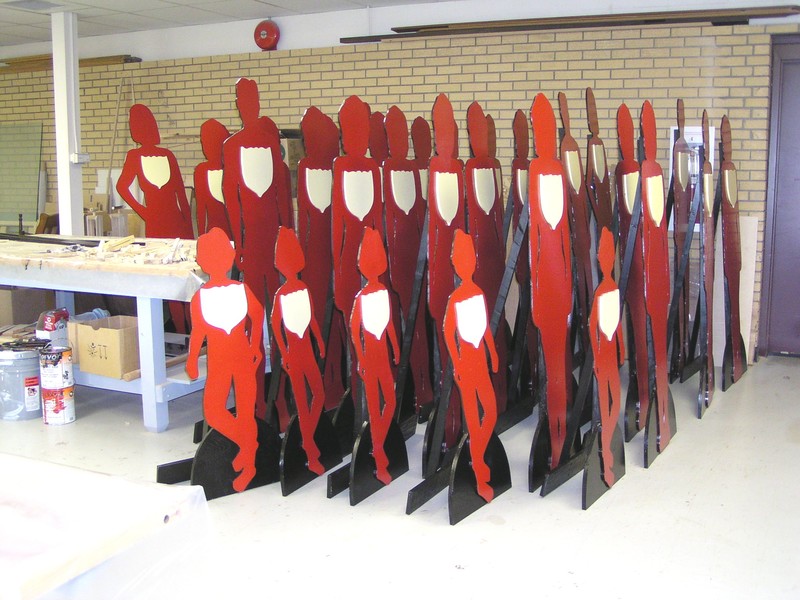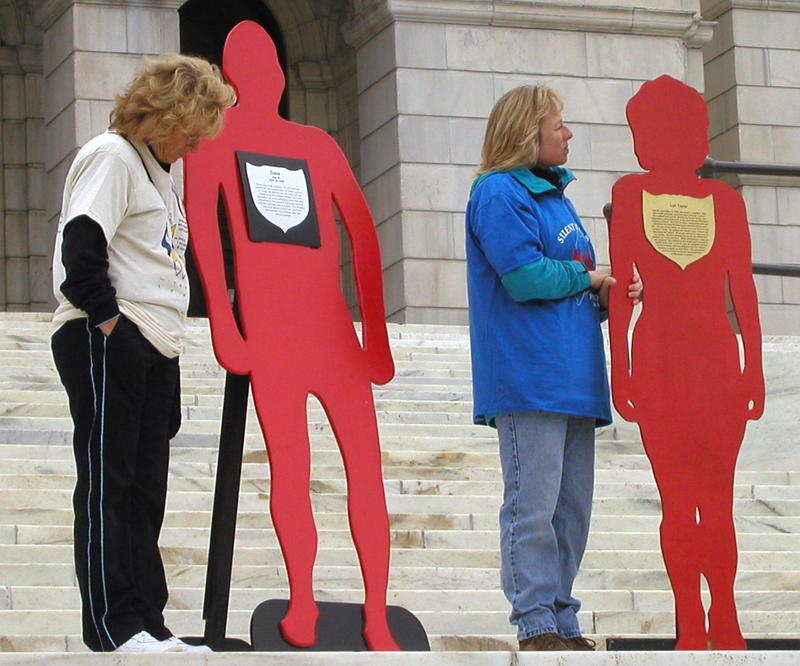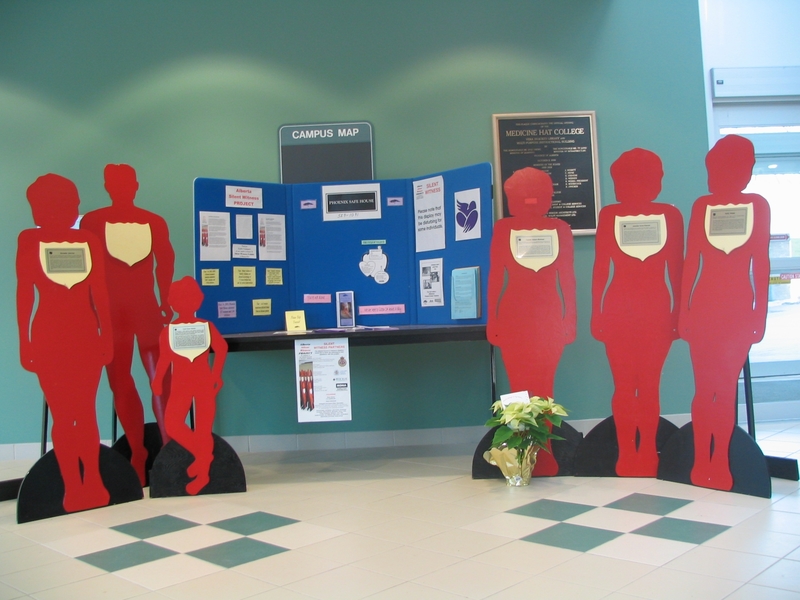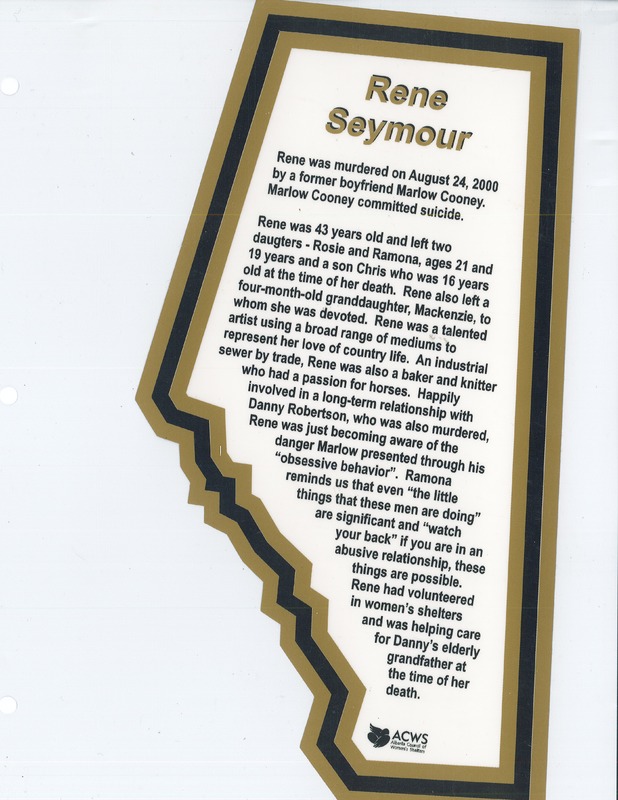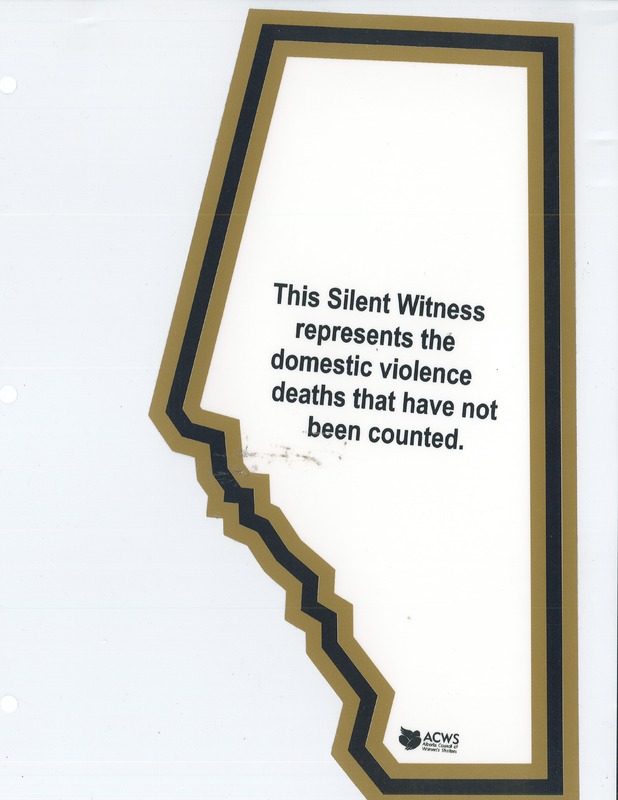The Silent Witness Project Exhibit
Historical background
The Silent Witness Project began as a US national initiative to honour women killed by their partners in acts of domestic violence. In 1990, an ad hoc group of women artists and writers, upset about the growing number of women in Minnesota being murdered by their partners, joined with women from other women’s organizations to form The Arts Action Against Domestic Violence. They felt an urgency to do something to commemorate and honour the lives of 26 women who had died in 1990 as a result of domestic violence.
They decided to create 26 free standing, life sized red wooden figures, each one bearing the name of a woman who once lived and worked in the community and whose life ended violently at the hands of her partner. A 27th figure was added to represent women whose murders went uncounted or unsolved. These wooden figures are called Silent Witnesses.
The Silent Witness Exhibit was officially launched on February 18, 1991, when more than 500 women marched single file, carrying the Witnesses, from a church, across the street to the Minnesota State Capitol Building. To date all 50 states, and several countries are participating in the project.
In November 2000, The Charlotte County Family Violence Committee collaborated with the Maine Silent Witness Project in a community education initiative for Family Violence Prevention Month. The Witnesses were brought to Charlotte County from Portland, Maine, and exhibited throughout the Country, including Saint John and Moncton. This display was so successful that the Charlotte County Family Violence Committee decided to bring the Silent Witness Initiative to New Brunswick – the first in Canada.
ACWS followed in the footsteps of our friends to the east and presented the first Silent Witness Initiative in the west during the Alberta Family Violence Prevention Month in November 2004.
ACWS’s Silent Witness Project
In 2012, the Alberta Council of Women’s Shelters (ACWS) displayed The Silent Witness Exhibit for over two weeks in Cold Lake, Alberta (Seraphim, 2012). Each red silhouette carries the name of a victim from Alberta who died from domestic violence. Yvette Houle, Executive Director of the Dr. Margaret Savage Crisis Centre said, “The Silent Witnesses help us understand that there are many victims of domestic violence living in every community in Alberta and that domestic abuse can escalate and lead to the deaths of these victims and their children.” Despite ACWS concentrating on women victims of abuse, the exhibit acknowledges sisters, brothers, boyfriends, fathers, or a child who have died because of family violence. Permission from the victims’ families had been granted for their lost loved one to be depicted in the exhibit.
The previous year, ACWS hosted “Take Back The Night” in Drumheller which was an event to share the stories of people who have died because of domestic violence in the hopes to spread awareness of this type of abuse (Drumheller Online, 2011). “Take Back The Night” also included a candlelight march throughout Downtown Drumheller. Those who participated were welcomed to make a pledge to take part in ending domestic violence.
The exhibit has been impactful in calling attention to domestic violence here in Alberta. In 2015, Strathcona County saw 840 cases of domestic violence reported to the RCMP. In 2016, the ACWS presented the Silent Witness Exhibit in Strathcona County throughout October. As a result of this exhibit, Saffron Centre, Men As Allies, A Safe Place, Victim Services as well as Strathcona County all committed to raise awareness of issues surrounding family violence.
Project Objectives
As exemplified by the New Brunswick Silent Witness Organizing Committee in 2005, project objectives include:
-
To remember people killed by their spouse/partner, ex-spouse/partner, or an intimate acquaintance
-
To raise awareness of domestic violence and partner homicide
-
To promote action in stopping partner violence especially among women and girls as they are most likely to be victims of violence, representing 67% of family violence victims in Canada in 2019 (Statistics Canada, 2021)
The silhouettes in the exhibit represent women and victims of triangulation killed in Alberta in acts of family violence. The determination that particular homicides were acts of family violence was based on thorough research in relation to the criteria below.
Who? Women killed in Alberta by their partners, ex-partners or acquaintances in acts of family violence where the perpetrator was charged and convicted, or the women were killed in documented cases of domestic murder/suicide. Victims of triangulation will also be represented in this display (children, boyfriends, other family members).
Family Violence Definitions
Family violence, sometimes called domestic violence, wife abuse or woman abuse, is the abuse and mistreatment of an individual in an intimate or family relationship. The abuser is typically the partner or ex-partner, or an acquaintance that was trying to have a relationship. The abuse can be physical, sexual, emotional, cultural, spiritual or financial in nature. It happens everywhere and to people from all backgrounds. In its most extreme form, family violence can result in severe injury and even homicide. Most of the victims are women.
Partners include a husband, ex-husband, common-law partner or boyfriend, ex-common-law partner, ex-boyfriend, or same sex partner.
Acquaintances might include co-workers, friends, or neighbours in circumstances where there has been an attempt to forcibly create an intimate relationship with the victim. This may involve stalking behaviour. The key is that the person who commits the murder is not a stranger to the women and has attempted to exert control over her.
Victims of triangulation are third party homicide victims whose deaths have been caused indirectly by a domestic dispute.
The project has honoured people who have become Silent Witnesses to domestic violence because their voices were robbed and subsequently silenced. By bringing their stories to light, the project not only gives them a chance for their voices to be heard but also delivers healing, hope, and an opportunity for others experiencing partner violence to raise their voices and seek safety, preventing future acts of domestic violence and death.
The collection currently tells the stories of 11 women, one child, and one man.
They stand in silence
They can’t speak a word,
Yet their voices need to be heard
Wooden silhouettes
of what they used to be…...
Reference
Drumheller Online. (2011, November 16). Take back the night gives voice to domestic violence. https://drumhelleronline.com/local/take-back-the-night-gives-voice-to-domestic-violence
New Brunswick Silent Witness Organizing Committee. (2005, April). The Silent Witness Canadian national initiative: A guide for establishing a Silent Witness Project in your province or territory. http://www.silentwitness.ca/uploads/pdf/canadian-guide-e.pdf
Seraphim, T. (2012, December 11). Silent Witness exhibit displayed in Cold Lake. The Cold Lake Sun. https://www.coldlakesun.com/2012/12/11/silent-witness-exhibit-displayed-in-cold-lake
Statistics Canada. (2021). Family violence in Canada: A statistical profile, 2019. (Catalogue number 85-002-X in Juristat). Retrieved August 8, 2021, from https://www150.statcan.gc.ca/n1/daily-quotidien/210302/dq210302d-eng.htm
Strathcona County. (2016, September 28). Reach out. Speak out: Don’t be a silent witness. https://www.strathcona.ca/council-county/news/news/2016/9/28/silent-witness/

